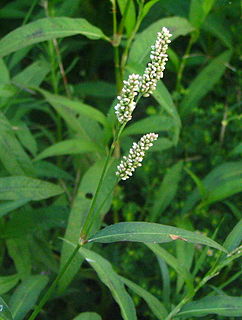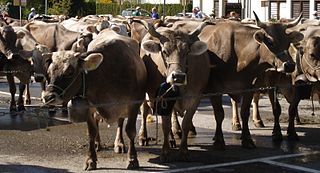
Rumex longifolius, commonly known as the dooryard dock or northern dock, is a perennial species of plant in the genus Rumex.

Barbarea orthoceras is a species of flowering plant in the mustard family known by the common name American yellowrocket. It is native to North America, including much of Canada and the western United States, as well as parts of Asia. It grows in moist areas such as meadows and riverbanks. This is a perennial herb producing a stiff, branching stem to heights between 10 and 60 centimeters. The leaves are a few centimeters long and generally oval in shape with several rounded lobes toward the end. The inflorescence is a spike or cluster of bright yellow flowers at the tip of each stem branch. The fruit is a straight, narrow silique up to 5 centimeters long.
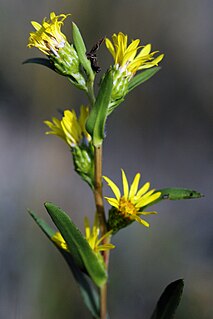
Pyrrocoma racemosa is a species of flowering plant in the aster family known by the common name clustered goldenweed. It is native to the western United States, where it grows in many types of habitat. It is quite variable in morphology, and there are several varieties which are sometimes hard to tell apart. In general, it is a perennial herb usually producing two or more mostly erect stems reaching maximum heights between 15 and 90 centimeters. The stems are reddish or brownish in color, leafy or not, and hairless to quite woolly. The longest leaves are located in tufts around the base of the stems. They are lance-shaped to oval, smooth-edged, wavy, or deeply spine-toothed, and may exceed 30 centimeters in length. Basal leaves are borne on woolly petioles. Leaves located higher on the stem lack petioles and may clasp the stem at their bases. The inflorescence is a cluster of several flower heads lined with phyllaries which may be over a centimeter long and are hairy to hairless in texture. Each head contains many yellow disc florets and a fringe of several yellow ray florets. The fruit is an achene which may be over a centimeter long including its pappus.
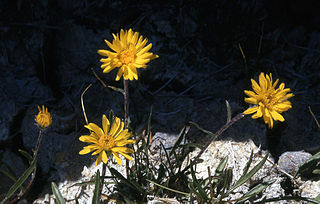
Pyrrocoma uniflora is a species of flowering plant in the aster family known by the common name plantain goldenweed. It is native to western North America from central Canada to California to Colorado, where it grows in several types of habitat, including forest and meadows with alkali soils, such as those near hot springs. It is a perennial herb growing up to 40 centimeters tall, the stems reddish and usually with a thin to thick coating of woolly fibers. The lance-shaped, toothed leaves are usually woolly, the largest near the base of the plant reaching up to 12 centimeters in length. The inflorescence is a single flower head or a cluster of a few heads, each lined with woolly phyllaries. The head contains yellow disc and ray florets. The fruit is an achene which may be over a centimeter long including its long pappus.

Ranunculus andersonii is a species of buttercup known by the common name Anderson's buttercup. It is native to the western United States, including the Great Basin and surrounding regions, where it grows in sagebrush, woodlands, and other habitat. It is a perennial herb producing a basal rosette of thick leaves which are each divided into three double-lobed leaflets at the end of a petiole. The inflorescence arises from the rosette on an erect, leafless stalk usually no more than 20 centimeters tall. It bears one flower with usually five white or red-tinged petals each up to 2 centimeters long with white or pinkish sepals at the base. At the center of the flower are many yellow stamens and pistils. The fruit is an achene, borne in a spherical cluster of 14 or more.
Rumex dentatus is a species of flowering plant in the knotweed family known by the common names toothed dock and Aegean dock. It is native to parts of Eurasia and North Africa, and it is widely known elsewhere as an introduced species. It grows in disturbed habitat, often in moist areas, such as lakeshores and the edges of cultivated fields. It is an annual or biennial herb producing a slender, erect stem up to 70 or 80 centimeters in maximum height. The leaves are lance-shaped to oval with slightly wavy edges, growing to a maximum length around 12 centimeters. The inflorescence is an interrupted series of clusters of flowers, with 10 to 20 flowers per cluster and each flower hanging on a pedicel. Each flower has usually six tepals, the 3 inner of which are edged with spinelike teeth and have tubercles at their centers.
Rumex kerneri is a species of flowering plant in the knotweed family known by the common name Kerner's dock. It is native to Europe. It has also been observed in California as an introduced species and roadside weed. It is a perennial herb producing a slender, erect stem from a thick taproot, approaching 1.5 meters in maximum height. The lance-shaped leaves can be up to 25 centimeters long and have smooth, wavy, or wrinkly edges. The inflorescence is an interrupted series of clusters of flowers, with 15 or 20 in each cluster, each flower hanging from a pedicel. The flower has usually six tepals, the inner three of which are largest, about 6 millimeters long, edged with tiny teeth and bearing rounded tubercles in the centers.
Rumex paucifolius is a species of flowering plant in the knotweed family known by the common name alpine sheep sorrel.

Rumex pulcher is a species of flowering plant in the knotweed family known by the common name fiddle dock. It is native to Eurasia and North Africa and it can be found elsewhere, including parts of North America, as an introduced species and a roadside weed. Europe. It is quite variable in appearance, and some authorities divide it into several subspecies that are more or less distinguishable. In general, it is a perennial herb producing a slender, erect stem from a thick taproot, approaching 70 centimeters in maximum height. The top of the plant may bend, especially as the fruit develops. The leaves are up to 10 or 15 centimeters long and variable in shape, though often oblong with a narrow middle in the rough shape of a fiddle. The inflorescence is made up of many branches, each an interrupted series of clusters of flowers with up to 20 in each cluster, each flower hanging from a pedicel. The flower has usually six tepals, the inner three of which are edged with teeth and have tubercles at their centers.

Rumex salicifolius is a species of flowering plant in the knotweed family known by the common names willow dock and willow-leaved dock. It is native to much of western North America and it can be found in parts of Europe as an introduced species and a roadside weed. It is an extremely variable plant which is generally divided into many varieties, some of which may actually be specimens of other species. In general, it is a perennial herb producing a slender stem which is prostrate and spreading or erect, growing up to about 90 centimeters in maximum length. The leaves are up to about 13 centimeters long and can be most any shape. The inflorescence is an interrupted series of clusters of flowers, with up to 20 in each cluster, each flower hanging from a pedicel. The flower has usually six tepals, the inner three of which are largest and usually have central tubercles. It is an important food and host plant for Lycaena rubidus larvae.

Rumex venosus is a species of flowering plant in the knotweed family known by the common names veiny dock, winged dock, and wild-begonia. While not of any particular agricultural use, its cousins rhubarb and buckweat are. It is native to central and western North America, from southern parts of the Canadian prairies, through to Mexico.

Sphaeralcea emoryi is a species of flowering plant in the mallow family known by the common name Emory's globemallow. It is native to the Southwestern United States, California and Northwestern Mexico. It grows in desert habitat and sometimes disturbed areas such as roadsides.

Sphaeralcea munroana is a species of flowering plant in the mallow family known by the common names Munro's globemallow and Munro's desert-mallow. It is native to the western United States, where it can be found in the Great Basin and surrounding regions. It grows in sagebrush, desert flats, and mountain slopes. This perennial herb produces erect stems up to about 80 centimeters tall from a thick root system. It is woolly and gray-green in color. The alternately arranged leaves have triangular blades up to 6 centimeters long, usually edged with large lobes and a toothed margin. Flowers occur in clusters on a raceme-like inflorescence. The flower has five apricot to red-orange petals each just over a centimeter long.

Stachys pycnantha is a species of flowering plant in the mint family known by the common name shortspike hedgenettle. It is native to California, where it is known from many types of mountain and foothill habitat. This mint produces several stems usually exceeding 60 centimeters in height. It is hairy and glandular and very aromatic. The leaves have lance-shaped or oval blades borne on short petioles. The inflorescence is usually a single cluster or interrupted series of a few clusters of flowers, with up to 12 flowers per cluster. The tubular corolla is up to a centimeter long and white to pink in color. It is borne in a hairy calyx of sepals.

Stenotus acaulis is a species of flowering plant in the aster family known by the common name stemless mock goldenweed.
Stephanomeria lactucina is a species of flowering plant in the aster family known by the common names lettuce wirelettuce and woodland wirelettuce. It is native to Oregon and California, where it grows in coastal and inland mountain ranges, including the Sierra Nevada. It can be found in many types of habitat, including coniferous forests. It is rhizomatous perennial herb producing a slender, erect stem reaching 30 to 60 centimeters in maximum height. The linear or lance-shaped leaves are up to 8 centimeters long and their edges are lined with widely spaced teeth. Solitary flower heads occur on erect peduncles. Each head contains up to 10 ray florets, each with an elongated tube and a fringed pink ligule roughly a centimeter long. The fruit is an achene tipped with a spreading cluster of long, plumelike pappus bristles.
Stephanomeria parryi is a species of flowering plant in the aster family known by the common name Parry's wirelettuce. It is native to the southwestern United States, where it grows in many types of habitat, including many desert areas. It is a perennial herb growing from a thick root and producing one or more slender, upright stems up to about 40 centimeters tall. The green leaves are linear to lance-shaped with lobed edges and are up to 8 centimeters long near the base of the plant. Flower heads occur on the spreading branches. Each has up to 13 or 14 ray florets, each with an elongated tube and a whitish ligule up to 1.5 centimeters long. The fruit is an achene tipped with a spreading cluster of long, tan, plumelike pappus bristles.
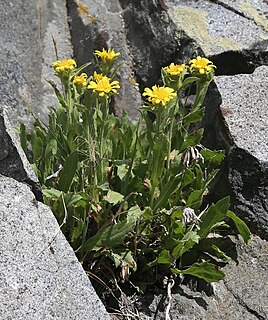
Tonestus peirsonii is a local-endemic species of flowering plant in the aster family known by the common names Inyo tonestus, Peirson's serpentweed and Peirson's tonestus.

Trifolium variegatum is a species of clover known by the common name whitetip clover. It is native to western North America from southern Alaska and British Columbia to Baja California, where it occurs in many types of habitat.

Rhamnus davurica is a species of flowering plant in the buckthorn family known by the common name Dahurian buckthorn. It is native to China, North Korea, Mongolia, eastern Siberia, and Japan. It is present in North America as an introduced species.

